Edward S. Curtis, Photographer "The following information is reprinted courtesy of the Edward S Curtis Gallery of edwardscurtis.com, whose site has copies of these incredible photogravures for sale. We have no commercial association with them, and have included this information because of its historical importance. Edward S. Curtis managed to assemble a vivid photographic accounting of the Native Americans westward, north and south from the Mississippi. As I researched his material, I was constantly overwhelmed by the beauty and significance of what he had to convey. I know that you'll agree that these works are very special."
Linda Hebert, www.basketweaving.com
Nez Pierce Basketry Edward S. Curtis Biography Other Native American Basketry Photos  
Edward Sheriff Curtis, Born in 1868 near Whitewater, Wisconsin, Edward Sheriff Curtis became one of America's finest photographers and ethnologists. When the Curtis family moved to Port Orchard, Washington in 1887, Edward's gift for photography led him to an investigation of the Indians living on the Seattle waterfront. His portrait of Chief Seattle's daughter, Princess Angeline, won Curtis the highest award in a photographic contest. Having become well-known for his work-with the Indians, Curtis participated in the 1899 Harriman expedition to Alaska as one of two official photographers. He then accompanied George Bird Grinell, editor of Forest and Stream, on a trip to northern Montana. There they witnessed the deeply sacred Sundance of the Piegan and Blackfoot tribes. Traveling on horseback, with their pack horses trailing behind, they emerged from the mountains to view the valley floor massed with over a thousand teepees - an awesome sight to Curtis and one that transformed his life. Everything fell into place at that moment: it was clear to him that he was to record, with pen and camera, the life of the North American Indian. Edward S. Curtis devoted the next 30 years photographing and documenting over eighty,tribes west of the Mississippi, from the Mexican border to northern Alaska. His project won support from such prominent and powerful figures as President Theodore Roosevelt and J. Pierpont Morgan. From 1911-1914 Curtis also produced and directed a silent film based on the mythology of the Rawakiutl Indians of the Pacific Northwest. Upon its completion in 1930, the work, entitled The North American Indian, consisted of 20 volumes, each containing 75 hand--pressed photogravures and 300 pages of text. Each volume was accompanied by a corresponding portfolio containing at least 36 photogravures.
Documentation of Nez Pierce Basketry and other handcrafts. Text by Edward S. Curtis
The handiwork of the Nez Perce's shows greater skill than is exhibited by that of the tribes of the plains. They made baskets and bags of several forms.
*A large cylindrical basket for the gathering and storage of roots was called kakapa; it was made of twine from Indian hemp and bear-grass, the latter forming the weft and the former the warp. The bear-grass was sometimes dyed blue, red, or yellow, the blue being made from lichens, the red and yellow from earth not burned or otherwise prepared.
*Kushh was a flat winnowing basket made of osiers and measuring twenty to twenty-four inches in diameter. *
*Pishkut, the mortar basket, was of the same material and shape; it was bottomless, as usual, and was fastened upright to a flat stone upon which the roots or seeds were pounded. It is probable that both the winnowing and the mortar basket of the Nez Perces were borrowed originally from the Shoshoni.
Cooking-vessels consisted of coiled baskets made of willow splints, and had the form of an inverted truncated cone. Flat bags or pouches were woven in several sizes. The smaller bags of this type were used by the women for containing their small, personal belongings, while the larger ones held the clothing and personal effects of the family. Both warp and weft were of hemp twine, the design being often produced or elaborated by the use of colored materials wrought into the surface by being caught under the horizontal threads as the bag was woven. Matting, woven from cattails or from tules, was made in great quantities, as it furnished the principal house-covering, served as mattresses, and, spread upon the ground, formed tables upon which to place the food, while small pieces were used in lieu of dishes. Spoons were carved from the frontal bone of the deer, from horn of the mountain-sheep, or from clam-shells. Bowls were hollowed out of soft wood, such as alder, by means of knives, which primitively were flakes of flint. Bows about three feet in length and of great strength were fashioned from mountainsheep horn, and were either of one piece or of two pieces spliced. Red cedar and syringa also were used. All well-made bows were strengthened with a backing of several layers of sinew. Arrows were principally of syringa. Flint-headed spears were sometimes used in war, also clubs consisting of a spherical stone wrapped in rawhide and provided with a wooden handle; such a weapon was called kaplafs. An effective armor was manufactured of rawhide taken from the neck of the bull-elk. This shirt of mail, called tukupailakt, protected the upper part of the body, had half-length sleeves, and was fastened at the front with thongs. The Nez Perce shield, which was used only by war-leaders and their principal followers, was made of doubled rawhide of the elk, unshrunken, and stretched over a wooden hoop; it sometimes bore painted representations of the war exploits of its owner. Quivers were made from the skin of the otter, coyote, cougar, or deer. Crude canoes were hewn from drift logs, usually cedar.
Other Basketry Photographs by Edward S. Curtis
Following are some examples of Edward S Curtis' photogravures of Native American basketry. I know that you'll be inspired by the pattern, shape and color of these works. If you visit the edwardscurtis gallery website, you'll find a map of North America which locates the tribal regions. Their site also has the text of many pages of Mr. Curtis' written documentation of his travels, with many well detailed descriptions of Native American life. 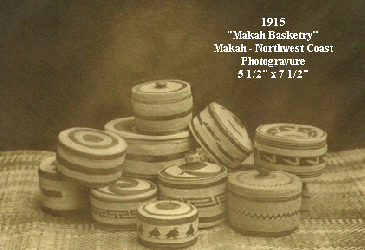 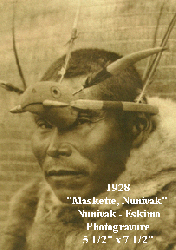 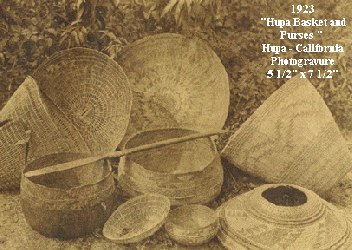 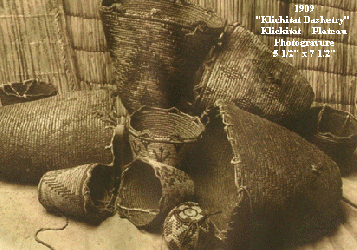  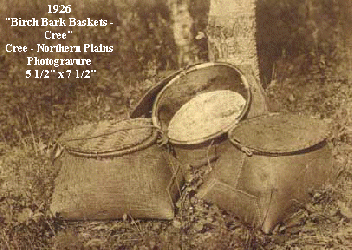  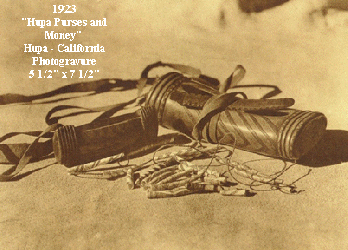 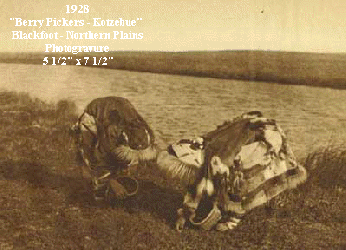 |












